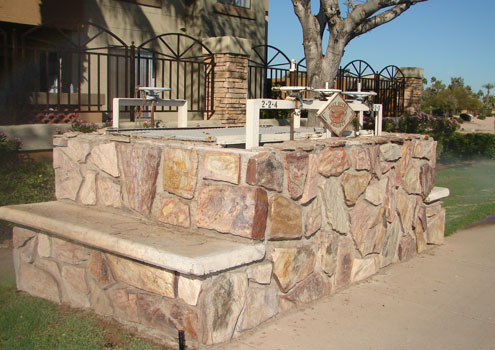Early Native Americans used logs and brush to build small dams to divert water from major canals into smaller canals to irrigate their crops. They constructed these early "head gates" by placing logs vertically in the canal as posts and packing brush and bundles of reeds tightly together between the posts to form a waterproof barrier.
Read more Water delivery structure
Water delivery structure
Today, the Phoenix area has its own version of this system. You may not know it, but evidence of the system is sprinkled throughout our neighborhoods.
So what are water delivery structures? They're the boxes with a wheel on top that are located near the canals and scattered throughout the Valley on many street corners, sometimes hidden in plain sight.
These simple mechanisms connect the large canals to smaller canals, or "laterals," which provide water to water treatment plants, neighborhoods, farms and businesses, such as golf courses.
By turning the wheel on top of the structure, water officials, or "zanjeros," control the flow of water to users downstream. SRP's head gates provide a variety of flows for water orders throughout the Valley, large and small.
Read more SRP's I.M. Clausen demonstrates the Clausen-Pierce weir gauge
SRP's I.M. Clausen demonstrates the Clausen-Pierce weir gauge
Over the years, many zanjeros and SRP employees have made their own contributions to the measurement systems and technology used in the canals. Two SRP employees, I.M. Clausen and R.A. Pierce, developed a weir gauge in the 1920s.
A weir is a barrier across a river designed to alter its flow characteristics. This Clausen-Pierce self-reading weir gauge helps measure water simply and accurately.
The device reads the highest wet spot on a measuring rod, which is then interpreted through a calculation table. Because of the high demand for this device in the Southwest, the two established their own separate measurement company in 1931.
The head gate is an essential tool for bringing water in the right amount at the right time to a desert community. In the Phoenix Valley, the people in charge of doing just that are the zanjeros.





